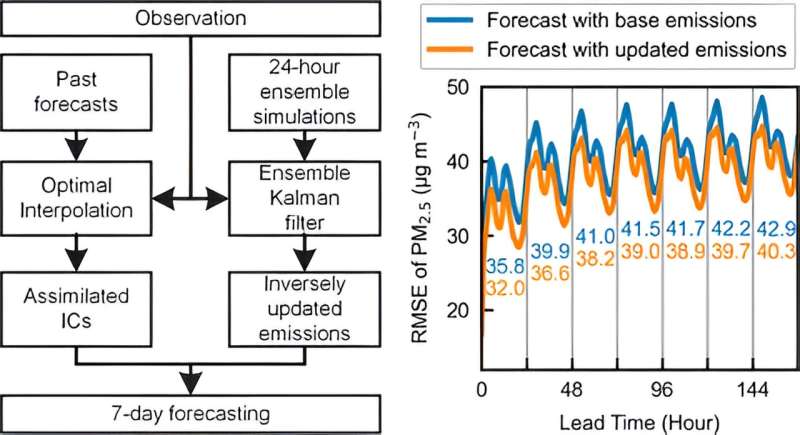This article has been reviewed according to Science X's editorial process and policies. Editors have highlighted the following attributes while ensuring the content's credibility:
fact-checked
peer-reviewed publication
trusted source
proofread
Improving air quality forecasting with daily update of emission inventory

In the realm of air quality forecasting, the precision of predictions largely hinges on the accuracy of emission inventory data. Traditional methods, which often update only once a year or less, face challenges in keeping pace with the dynamic nature of air pollutant emissions. This issue is particularly significant in China, where rapid changes in atmospheric pollutants demand a more agile approach.
Addressing this challenge, a recent study by the Institute of Atmospheric Physics, published in Environmental Science & Technology Letters and featured as a supplementary cover of the journal, has proposed an innovative emission update scheme tailored for air quality forecasting.
According to the first author Dr. Huangjian Wu, the strength in the new approach lies in that, in contrast to conventional methodologies, the new approach significantly reduces computational demands by an impressive 84%, making ensemble-based emission inversion cost-effective and practical for operational air quality forecasting.
Co-author Prof. Xiao Tang explained the essence of the approach, "Our methodology builds upon the ChemDAS data assimilation system and takes a significant step forward by decoupling ensemble simulations and forecasts required for emission inversion. This enables the daily estimation of emissions for major pollutants in urban areas."
This is echoed by Dr. Lei Kong, another contributor to the study, "Our technique estimates emissions for key pollutants like CO, SO2, NOx, VOCs, and PM2.5 and PM10 precursors by assimilating observed concentrations of CO, SO2, NO2, O3, PM2.5, and PM10, respectively."
The innovative method has already been successfully implemented at the China National Environmental Monitoring Centre (CNEMC), where it facilitates online inversion and updates of emission inventories for operational forecasting. "Our approach not only enhances forecast accuracy but also enables timely assessments of changes in atmospheric pollutant emissions," emphasized Prof. Zifa Wang, the corresponding author of the study.
In testing conducted between January and February 2022, the new method led to a notable 7.1% reduction in root mean square errors in 7-day PM2.5 forecasts and significantly improved predictions for pollutants like O3. Moreover, the updated emission data revealed significant reductions in nitrogen oxide emissions during the 2022 Beijing Winter Olympics, with Beijing experiencing a 53.5% reduction, Zhangjiakou a 42.7% reduction, and Hebei Province a 48.6% reduction.
This approach could advance air quality forecasting by providing timely, accurate, and cost-effective emission updates, contributing to the goal of healthier air for all.
More information: Huangjian Wu et al, Air Quality Forecasting with Inversely Updated Emissions for China, Environmental Science & Technology Letters (2023). DOI: 10.1021/acs.estlett.3c00266
Journal information: Environmental Science & Technology Letters
Provided by Chinese Academy of Sciences




















